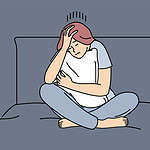Life is busy. Racing to fit work, school, kids, chores and time for yourself into a day can be overwhelming. You can often feel the need to sacrifice sleep to get it all done. Let’s start with identifying why you don’t have time for sleep. Then we can talk about how to make time to sleep by setting priorities. Learn what naps can do to your sleep schedule and how to create habits and cues to fall asleep more easily and get more quality from your sleep when bedtime does arrive.
Table of Contents
Why don’t I have enough time for sleep?
You had so much to do today. You’re stressed. The demands of work, followed by errands and stops along the way. You get through dinner and finally get the kids in bed.
Are studies still on the agenda? What’s left? You don’t want to go to bed yet. The morning will come too soon and you will have to start it all over again. You just want a little time for you. So you stay up longer.
Known as “revenge bedtime procrastination”, some people stay up late to have leisure time for things they like to do, they sacrifice sleep for personal time when the larger part of their day is taken up by their jobs and they feel the need to have more time for themselves
How do I make time for sleep?
To start off, creating a consistent sleep schedule is important. Make it a priority. Plan for 7-9 hours per night starting and ending at the same time each day. Your body and your brain have an internal clock that tells you when to sleep. You may have heard of circadian rhythm before.
Regulated primarily by light you get during the day, you can use it as a guide to your sleep schedule. You have some control over it by making sure you get enough light early in the day and dimming the light when it gets close to bedtime.
Try to sync your bedtime to your own rhythm to create a sleep schedule that works for you. Practicing good sleep hygiene in your routines can help you tune into a better rhythm.
Not everyone has a simpler life. For busy lifestyles some of these tips for managing your time may help you to work smarter not harder and make more time for sleep.
- Organize – Clutter and disorganization can suck up a lot of time when you need to get something done and every 5 minute task turns into 30 because you can’t find something or navigate a task as expected.
- Set priorities – list all your tasks, identify what’s important to achieve your desired goals, prioritize in order of importance and highlight anything urgent or time sensitive, keep in mind the amount of time and effort required for each task and break down into individual steps if needed, review on a regular basis as priorities can change
- Delegate – Lesser tasks that can be done by someone else or automated can shorten time taken from you. Save your own time for things that cannot be done by someone else.
- Don’t overestimate what you can do in a day. Be realistic, and when needed adjust your expectations, so you can leave time for sleep.
- Set a time to call it a day. Know your limits. The average person needs 7 to 9 hours of sleep per night. By doing high priority tasks first the ones left can roll over to the next day.
- Tell yourself it’s ok to let go of things. Anxiety can often keep you awake longer.
I keep a list and I highlight what is most important along my way each day. I set my errands to be done while I am already going that direction, so I don’t take extra time to go out of my way or make extra trips that take more time.
I know I won’t get everything done, but I will get what is most important or urgent accomplished. The lesser tasks can be left to the next day or re-evaluated to determine if it is still needed.
Naps
Napping won’t replace a good night of sleep but when you can’t get enough sleep at night even a short 20-minute rest can have a significant impact in your performance for the rest of the day.
Fact: A daytime nap reverses the difficulty you have processing information to perform mental tasks as well as the frustration and irritability that comes with a lack of sleep.
But, don’t nap too long or too late or it can mess with your sleep schedule. Try to nap for no more than 20 to 40 minutes. Sleeping longer may make you feel groggy afterward.
Because of the sleep-wake cycle in older adults, the optimum time for a nap is between 1 and 4 p.m. This post lunch circadian dip period provides more restorative benefits than naps taken earlier or later in the day according to research.
What is the 30 90 rule for napping
You want to nap for 30 minutes or less to wake refreshed and not groggy. During the first 30 minutes you are in a light phase of sleep. Then you cycle through a deeper phase between the 30 minute and 75 minute marks.
Waking from deep sleep tends to bring you back in a groggy state of mind. A complete sleep cycle typically lasts about 90 minutes. So, ideally you want to sleep 30 minutes or less or at least 90 minutes. Hence, the 30-90 rule.
Creating Habits and Cues that Promote Sleep
We are creatures of habit. Habits build our routines, and they can help or hinder us. You need to train your brain with cues to wind down and be able to go to sleep quickly when it is time to sleep. These become bedtime rituals that your brain recognizes as signals that it needs to begin winding down toward sleep.
Sleep Rituals
These cues may include many things your mother told you to do before you went to bed such as putting on your pajamas and brushing your teeth. She knew best.
Quiet time and turning down the lights was a common practice in my youth.
Your brain recognizes these repetitive routines leading up to bedtime and comes to expect sleep to follow.
Many people like to incorporate a relaxing shower or a calming activity such as meditation or yoga. Reading, aromatherapy or listening to music are other relaxing activities that can be included in your bedtime routine.
Choose what works best for you and make it a nightly practice to help you to feel sleepy bedtime. Last of all, set yourself a time for lights out.
The Sleep Rule: 10-3-2-1-0
Daily habits and sleep rituals relate to sleep hygiene. The 10-3-2-1-0 sleep rule is a good guideline to proper sleep hygiene. It states:
10 hours before bed: No more caffeine.
3 hours before bed: No more food or alcohol.
2 hours before bed: No more work.
1 hour before bed: No more screen time (shut off all blue light devices such as phones, TVs and computers, this includes video games).
0: The number of times you hit snooze in the morning.
Learn to let go
Anxiety is one of the most common reasons people can’t go to sleep. Its ok to let go of your worries and concerns for the day. You have to tell yourself this.
A good night of sleep will help you better deal with them tomorrow and there is nothing more you can do about things at bedtime. Here is how you do it:
- write down your worry list- any concerns or things you need to remember, I keep a pad and pen right next to my bed. If I wake in the night suddenly with something on my mind I write it down so I can go back to sleep without worrying I will forget before morning.
- create a diversion to get your mind off of things – This is where reading or listening to music can help you focus away from the events of your day and can be part of your bedtime ritual. It may run contradictory, but I find 15 to 20 minutes of a slow program on TV can help me do this also.
- I once met someone who developed a unique routine. When they came home each night, they would take off an imaginary coat and hat and hang it on an imaginary hook. In doing so they acknowledged to themselves that they were hanging all the problems of the day at the door until tomorrow. They made a line between home and work and left it at the door when they came in.
Conclusion
Life can wear you down, but without a good night of sleep you can’t keep up for long or enjoy the things you like.
Sleep is important for your physical and mental health. Making time for it should be important too. Learn to assign priorities to daily tasks, organize and delegate, practice good sleep hygiene , give cues for sleep and nighttime rituals, and let go when it’s time.
Tomorrow will still be there and you will be able to deal better with a good night of sleep.
Whatever technique you find, letting go is the key to making time to sleep. No amount of time can be enough if you won’t let go of what you are doing and allow yourself the time for sleep. You have to draw the line.
Sleep well,
Goodnight!

The information in today’s post is for educational and informational purposes only and is not intended to be a substitute for professional medical advice, diagnosis, or treatment. When you have questions regarding your health you should seek the advice of your health care provider.
Related topics
How to Help Anxiety so you can Sleep

Sleep Deprived? Discover 7 Science-Backed Solutions for a Restful Night’s Sleep


